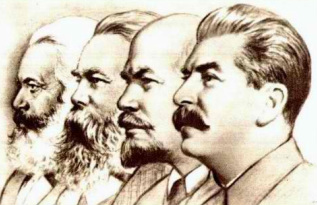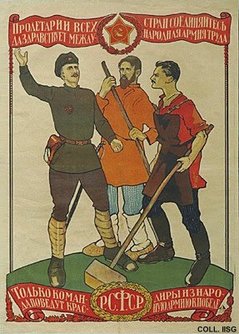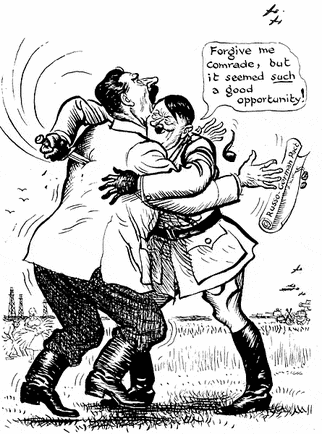Communism
Marx and Engels

Marx, Engels, Lenin, Stalin.
Written in 1848, The Communist Manifesto formed the basis of classical Marxism. German philosophers Karl Marx and Friedrich Engels would shape the next century's worldwide political scene with their vision of history: in the end, the proletariat will lead a worldwide revolution to rid social classes, ending the class struggle that has oppressed them for so long. Capitalism was shunned; instead, the government would make all economic decisions in order for there to be common ownership of all goods. This echoed the concerns of workers, and various socialist parties grew somewhat in Europe as the 20th century approached. However, the first actual revolution occurred in Russia, where Bolshevism with its key events leading to World War II was born.
Vladmir Ilyich Ulyanov

Bolshevik soldier, farmer, and worker.
Lenin with his Bolshevik party fed on a collapsing government under tsar Nicholas II to take control of Russia during World War I, which had severely drained Russian resources. Peasants were starving and more and more troops were dying for what originally seemed like a quick war. World War I directly caused Russia's turmoil, letting it turn to the communism that fascists such as Hitler and Mussolini would vehemently rally against twenty years later.
By November 1917, Lenin assumed control of Russia and immediately pulled out of World War I, ceding territory to Germany. A small elite ruled, contrary to Marx's ideas. The Union of Soviet Socialist Republics (USSR) was established. Economically, Lenin pursued the successful New Economic Plan, which allowed some capitalism, giving back land to peasants and letting small businesses grow.
By November 1917, Lenin assumed control of Russia and immediately pulled out of World War I, ceding territory to Germany. A small elite ruled, contrary to Marx's ideas. The Union of Soviet Socialist Republics (USSR) was established. Economically, Lenin pursued the successful New Economic Plan, which allowed some capitalism, giving back land to peasants and letting small businesses grow.
Man of Steel
Joseph Stalin took power after Lenin's death in 1924. A totalitarian state was established with censorship and secret police, and Lenin's NEP was replaced with Five-Year Plans aimed at strengthening the country through heavy production. Other countries looked up to the Soviets' ongoing experiment with communism while struggling during the Great Depression. Peasants were forced to live on collectives and give grain to the state, resulting in millions of deaths through famine. In 1934, Stalin's Great Purge wiped out old Bolsheviks people might look up to in a paranoid manner. By the late 1930s, the Soviet Union was feared by both fascists and democracies for its communism. The Treaty of Versailles' weak creation of Poland invited Hitler and Stalin to agree to divide it up, and in August 1939, despite ideological differences, the Nazi-Soviet Pact was signed as the immediate precursor to World War II.

